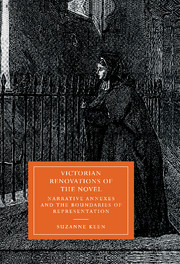Book contents
- Frontmatter
- Contents
- Acknowledgments
- 1 Narrative annexes: altered spaces, altered modes
- 2 Victorian critics, narrative annexes, and prescriptions for the novel
- 3 Norms and narrow spaces: the gendering of limits on representation
- 4 Narrative annexes, social mobility, and class anxiety
- 5 Older, deeper, further: narrative annexes and the extent of the Condition of England
- 6 Victorian annexes and modern form
- Notes
- Bibliography
- Index
- CAMBRIDGE STUDIES IN NINETEENTH-CENTURY LITERATURE AND CULTURE
2 - Victorian critics, narrative annexes, and prescriptions for the novel
Published online by Cambridge University Press: 13 November 2009
- Frontmatter
- Contents
- Acknowledgments
- 1 Narrative annexes: altered spaces, altered modes
- 2 Victorian critics, narrative annexes, and prescriptions for the novel
- 3 Norms and narrow spaces: the gendering of limits on representation
- 4 Narrative annexes, social mobility, and class anxiety
- 5 Older, deeper, further: narrative annexes and the extent of the Condition of England
- 6 Victorian annexes and modern form
- Notes
- Bibliography
- Index
- CAMBRIDGE STUDIES IN NINETEENTH-CENTURY LITERATURE AND CULTURE
Summary
Throughout this study I emphasize the prescriptions and warnings of Victorian critics, and I chart their reactions to narrative annexes in order to illuminate Victorians' assumptions about the proper roles, shapes, and subjects of fiction. I introduce in this chapter the vocabulary of realm, domain, and boundary shared by Victorian critics and writers of fiction, and I begin to show how the small alternative zones of narrative annexes fit in a theory of the Victorian novel, even as they test the Victorians' ordinances regarding the shapes and contents of fiction. A related aim of this chapter is to show how recognition of narrative annexing contributes to a broader account of the limitations and capacities of Victorian fiction. For many Victorian novels, not even counting the reams of formula fiction written for the circulating libraries, do not employ narrative annexes. Just as most Victorian novels present their events without flashbacks, most first-person narratives do without access to the consciousnesses of other characters, and many novels set in the country do not require an excursion to the city, many Victorian novels accomplish their narrative work without annexes. While keeping in mind the heterogeneity of the Victorian novel in its many genres, its diverse modes of publication, its various (overlapping and sometimes antithetical) aims – to entertain, instruct, titillate, support the author's family, record abuses, instigate reform, indoctrinate, and express visions of community and versions of character – the presence or absence of narrative annexes contributes to our understanding of the novel as a product of a particular time and culture.
- Type
- Chapter
- Information
- Victorian Renovations of the NovelNarrative Annexes and the Boundaries of Representation, pp. 42 - 64Publisher: Cambridge University PressPrint publication year: 1997



